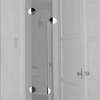Free Online Productivity Tools
i2Speak
i2Symbol
i2OCR
iTex2Img
iWeb2Print
iWeb2Shot
i2Type
iPdf2Split
iPdf2Merge
i2Bopomofo
i2Arabic
i2Style
i2Image
i2PDF
iLatex2Rtf
Sci2ools
ICCV
2003
IEEE
2003
IEEE
On Exploiting Occlusions in Multiple-view Geometry
Occlusions are commonplace in man-made and natural environments; they often result in photometric features where a line terminates at an occluding boundary, resembling a "T". We show that the 2-D motion of such Tjunctions in multiple views carries non-trivial information on the 3-D structure of the scene and its motion relative to the camera. We show how the constraint among multiple views of T-junctions can be used to reliably detect them and differentiate them from ordinary point features. Finally, we propose an integrated algorithm to recursively and causally estimate structure and motion in the presence of T-junctions along with other point-features.
2-D Motion | Computer Vision | Estimate Structure | ICCV 2003 | Multiple Views | Ordinary Point Features |
Related Content
| Added | 15 Oct 2009 |
| Updated | 31 Oct 2009 |
| Type | Conference |
| Year | 2003 |
| Where | ICCV |
| Authors | Paolo Favaro, Alessandro Duci, Yi Ma, Stefano Soatto |
Comments (0)

